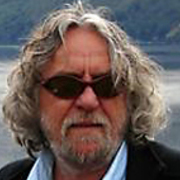
Dan Hennah
Oscar-winner Dan Hennah has worked a range of screen projects, from contemporary and period tales to a slew of big-budget fantasies.
Born in Hastings and raised on a nearby farm, Dan Hennah began studying architecture at the age of 17. He went on to five years working for various architects in Wellington and Nelson, including time with Ian Athfield.
Keen to get out from behind a drawing board, Hennah had just finished a season on a fishing trawler when a friend told him about a film gig, as a driver for American actor Tatum O'Neal. Hennah got the job. Although the movie was never released, Hennah was fascinated by the filmmaking process. Despite his lack of industry experience, his familiarity with boating and architecture quickly helped him score a gig as one of two art directors (with Rick Kofoed) on big-budget South Seas adventure Savage Islands.
Hennah would work in the locations department on a couple of screen projects, but the art department was to become his second home. In the 1980s he was an art director on two period melodramas: Heart of the High Country, land Jodie Foster movie Mesmerized, plus Disney adventure The Rescue.
By 1993 Hennah had graduated to the top of the design totem pole, as production designer of locally-shot, Canadian-financed tele-movie Adrift. The remainder of the decade saw him alternating the roles of production designer and art director. Hennah worked on a number of shows for Cloud Nine, including production designing the company's breakout hit, dystopian adventure The Tribe.
In 1996 Hennah worked for the first time with Peter Jackson on The Frighteners, Jackson's first production for a Hollywood studio. In a reversal of the dream factory norm, Hennah and production designer Grant Major created and exported to Hollywood the fictional North American town of Fairwater, without leaving New Zealand.
"I'd been art directing for 20-odd years," Hennah told Pavement magazine, "but to then come across this guy who has so much vision and so much focus, that was pretty amazing. So the transition from The Frighteners to The Lord of the Rings wasn't that hard because we knew what we were dealing with ... you know you always have to go that step further, try that little bit harder."
Major again took on the lead role of production designer for the Rings trilogy, with Hennah working variously as set decorator and ultimately lead art director (Hennah's wife Chris managed the art department). His favourite — and toughest — set was Edoras, home of the horse-riding Rohan people. The 12-metre high set, complete with thatched roof, was built during winter, "on a mountain in the middle of a river valley surrounded by the Southern Alps. It was 1500 metres from the road, through three rivers and various other small challenges, and winds blowing up to 190 km/h."
For Hennah, art directing is about delivering on time and budget. He describes the job as being "all about making it happen ... it's not so much about doing the drawings, it's about picking the drawings up and saying we're going to do this this way, we're going to make it happen in this much time for this much money."
Nominated for another Oscar for his work as lead art director on Jackson's remake of King Kong, Hennah graduated to production designer duties on two movies shot down under: Underworld prequel Rise of the Lycans (directed by French/Greek production designer Patrick Tatopoulos), and big budget Asian Western The Warrior's Way. Variety reviewer Joe Leydon wrote of Lycans: "ace production design emphasises a Dark Ages version of the black-on-black, Goth-flavoured look of the earlier pics."
Hennah then returned to Middle-earth (working this time on a much tighter time frame than for Lord of the Rings) to take over the reins as production designer on Peter Jackson's adaptation of The Hobbit. A slew of nominations flowed in Hennah's direction, after the release of the first film in the trilogy.
Since then, Hennah has been the production designer on such major films as Tim Burton's Alice Through the Looking the Glass, Taika Waititi's Thor: Ragnarok and Christian River's New Zealand-shot Mortal Engines. In 2023, he helmed production design for the television adaption of the Percy Jackson and the Olympians book series — which includes the major task of designing the Underworld of Greek mythology.
Sources include
Joe Leydon, 'Underworld: Rise of the Lycans' (Review) - Variety, 23 January 2009
Ayla Ruby, 'NYCC Interview: Dan Hennah and Tish Monaghan Talk ‘Percy Jackson and the Olympians’' (Interview) - Cosmic Cinema website, 26 October 2023. Accessed 1 July 2025
'Art Director/Production Designer - Dan Hennah' (Interview) M2E Pictures website. Accessed 26 November 2012
The Lord of the Rings: The Two Towers Press Kit